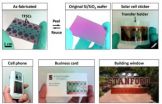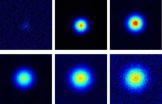(Press-News.org) A coherent pathway which starts from no more than rocks, water and carbon dioxide and leads to the emergence of the strange bio-energetic properties of living cells, has been traced for the first time in a major hypothesis paper in Cell this week.
At the origin of life the first protocells must have needed a vast amount of energy to drive their metabolism and replication, as enzymes that catalyse very specific reactions were yet to evolve. Most energy flux must have simply dissipated without use.
So where did it all that energy come from on the early Earth, and how did it get focused into driving the organic chemistry required for life?
The answer lies in the chemistry of deep-sea hydrothermal vents. In their paper Nick Lane (UCL, Genetics, Evolution and Environment) and Bill Martin (University of Dusseldorf) address the question of where all this energy came from - and why all life as we know it conserves energy in the peculiar form of ion gradients across membranes.
"Life is, in effect, a side-reaction of an energy-harnessing reaction. Living organisms require vast amounts of energy to go on living," said Nick Lane.
Humans consume more than a kilogram (more than 700 litres) of oxygen every day, exhaling it as carbon dioxide. The simplest cells, growing from the reaction of hydrogen with carbon dioxide, produce about 40 times as much waste product from their respiration as organic carbon (by mass). In all these cases, the energy derived from respiration is stored in the form of ion gradients over membranes.
This strange trait is as universal to life as the genetic code itself. Lane and Martin show that bacteria capable of growing on no more than hydrogen and carbon dioxide are remarkably similar in the details of their carbon and energy metabolism to the far-from-equilibrium chemistry occurring in a particular type of deep-sea hydrothermal vent, known as alkaline hydrothermal vents.
Based on measured values, they calculate that natural proton gradients, acting across thin semi-conducting iron-sulfur mineral walls, could have driven the assimilation of organic carbon, giving rise to protocells within the microporous labyrinth of these vents.
They go on to demonstrate that such protocells are limited by their own permeability, which ultimately forced them to transduce natural proton gradients into biochemical sodium gradients, at no net energetic cost, using a simple Na+/H+ transporter. Their hypothesis predicts a core set of proteins required for early energy conservation, and explains the puzzling promiscuity of respiratory proteins for both protons and sodium ions.
These considerations could also explain the deep divergence between bacteria and archaea (single celled microorganisms) . For the first time, says Lane, "It is possible to trace a coherent pathway leading from no more than rocks, water and carbon dioxide to the strange bioenergetic properties of all cells living today."
###
Notes for Editors
1. For more information, please contact Nick Lane on nick.lane@ucl.ac.uk
2. Alternatively, please contact Clare Ryan in the UCL Media Relations Office on tel: +44 (0)20 3108 3846, mobile: +44 07747 556 056, out of hours +44 (0)7917 271 364, e-mail: clare.ryan@ucl.ac.uk
3. 'The Origin of Membrane Bioenergeticsis' published in the journal Cell on 21st December and is embargoed to 12pm (US, EST) on December 20th. Journalists can obtain copies of the paper by contacting [either the UCL Media Relations Office.
4. The study was funded by a UCL Provost's Venture Research Fellowship, the Leverhulme Trust and the European Research Council.
About UCL (University College London)
Founded in 1826, UCL was the first English university established after Oxford and Cambridge, the first to admit students regardless of race, class, religion or gender and the first to provide systematic teaching of law, architecture and medicine.
We are among the world's top universities, as reflected by our performance in a range of international rankings and tables. According to the Thomson Scientific Citation Index, UCL is the second most highly cited European university and the 15th most highly cited in the world.
UCL has nearly 25,000 students from 150 countries and more than 9,000 employees, of whom one third are from outside the UK. The university is based in Bloomsbury in the heart of London, but also has two international campuses – UCL Australia and UCL Qatar. Our annual income is more than £800 million.
www.ucl.ac.uk | Follow us on Twitter @uclnews | Watch our YouTube channel YouTube.com/UCLTV
Origin of life emerged from cell membrane bioenergetics
2012-12-20
ELSE PRESS RELEASES FROM THIS DATE:
A urine test for a rare and elusive disease
2012-12-20
Boston, Mass.—A set of proteins detected in urine by researchers at Boston Children's Hospital may prove to be the first biomarkers for Kawasaki disease, an uncommon but increasingly prevalent disease which causes inflammation of blood vessels that can lead to enlarged coronary arteries and even heart attacks in some children. If validated in more patients with Kawasaki disease, the markers could make the disease easier to diagnose and give doctors an opportunity to start treatment earlier.
The discovery was reported online by a team led by members of the Proteomics Center ...
First ever 'atlas' of T cells in human body
2012-12-20
New York, NY (December 20, 2012) — By analyzing tissues harvested from organ donors, Columbia University Medical Center (CUMC) researchers have created the first ever "atlas" of
immune cells in the human body. Their results provide a unique view of the distribution and function of T lymphocytes in healthy individuals. In addition, the findings represent a major step toward development of new strategies for creating vaccines and immunotherapies. The study was published today in the online edition of the journal Immunity.
T cells, a type of white blood cell, play a major ...
Peel-and-Stick solar panels from Stanford engineering
2012-12-20
For all their promise, solar cells have frustrated scientists in one crucial regard – most are rigid. They must be deployed in stiff, often heavy, fixed panels, limiting their applications. So researchers have been trying to get photovoltaics to loosen up. The ideal: flexible, decal-like solar panels that can be peeled off like band-aids and stuck to virtually any surface, from papers to window panes.
Now the ideal is real. Stanford researchers have succeeded in developing the world's first peel-and-stick thin-film solar cells. The breakthrough is described in a ...
Cellphone, GPS data suggest new strategy for alleviating traffic tie-ups
2012-12-20
Asking all commuters to cut back on rush-hour driving reduces traffic congestion somewhat, but asking specific groups of drivers to stay off the road may work even better.
The conclusion comes from a new analysis by engineers from the Massachusetts Institute of Technology and the University of California, Berkeley, that was made possible by their ability to track traffic using commuters' cellphone and GPS signals.
This is the first large-scale traffic study to track travel using anonymous cellphone data rather than survey data or information obtained from U.S. Census ...
Research pinpoints key gene for regenerating cells after heart attack
2012-12-20
DALLAS – Dec. 20, 2012 – UT Southwestern Medical Center researchers have pinpointed a molecular mechanism needed to unleash the heart's ability to regenerate, a critical step toward developing eventual therapies for damage suffered following a heart attack.
Cardiologists and molecular biologists at UT Southwestern, teaming up to study in mice how heart tissue regenerates, found that microRNAs – tiny strands that regulate gene expression – contribute to the heart's ability to regenerate up to one week after birth. Soon thereafter the heart loses the ability to regenerate. ...
Shedding light on Anderson localization
2012-12-20
This press release is available in German.
Waves do not spread in a disordered medium if there is less than one wavelength between two defects. Physicists from the universities of Zurich and Constance have now proved Nobel Prize winner Philip W. Anderson's theory directly for the first time using the diffusion of light in a cloudy medium.
Light cannot spread in a straight line in a cloudy medium like milk because the many droplets of fat divert the light as defects. If the disorder – the concentration of defects – exceeds a certain level, the waves are no longer ...
Small wasps to control a big pest?
2012-12-20
With the purpose of developing new biological methods to control one of the major pests affecting the southwest Europe pine stands, a joint collaboration leaded by the Instituto Nacional de Investigação Agrária e Veterinária, Portugal (R. Petersen-Silva, P. Naves, E. Sousa), together with the Universidad de Barcelona, Spain (J. Pujade-Villar) and a member of the Museum and Institute of Zoology from the Polish Academy of Sciences, Poland, (S. Belokobylskij) initiated a research to detect the parasitoid guild of the Pine Wood Nematode (PWN) vector, Monochamus galloprovincialis ...
Sync to grow
2012-12-20
From a single-cell egg to a fully functional body: as embryos develop and grow, they must form organs that are in proportion to the overall size of the embryo. The exact mechanism underlying this fundamental characteristic, called scaling, is still unclear. However, a team of researchers from EMBL Heidelberg is now one step closer to understanding it. They have discovered that scaling of the future vertebrae in a mouse embryo is controlled by how the expression of some specific genes oscillates, in a coordinated way, between neighbouring cells. Published today in Nature, ...
Silver sheds light on superconductor secrets
2012-12-20
The first report on the chemical substitution, or doping, using silver atoms, for a new class of superconductor that was only discovered this year, is about to be published in EPJ B. Chinese scientists from Institute of Solid State Physics, Chinese Academy of Sciences, Hefei, discovered that the superconductivity is intrinsic rather than created by impurities in this material with a sandwich-style layered structure made of bismuth oxysulphide (Bi4O4S3).
Superconductors with a transition temperature (TC) above the boiling temperature of liquid nitrogen (77 kelvins or −196 ...
Gene expression improves the definition of a breast cancer subtype
2012-12-20
The study conducted by the Vall d'Hebron Institute of Oncology (VHIO) in conjunction with the GEICAM cooperative group and other American and Canadian researchers has led to a change in the definition of hormone-sensitive breast tumours.
Barcelona, 20 December 2012. Gene expression in breast cancer provides valuable biological information for better determining the diagnosis, treatment, risk of relapse and survival rate. However, the most common form of characterizing breast cancer is by histopathological techniques. This study, headed by Dr Aleix Prat, Head of the Translational ...



